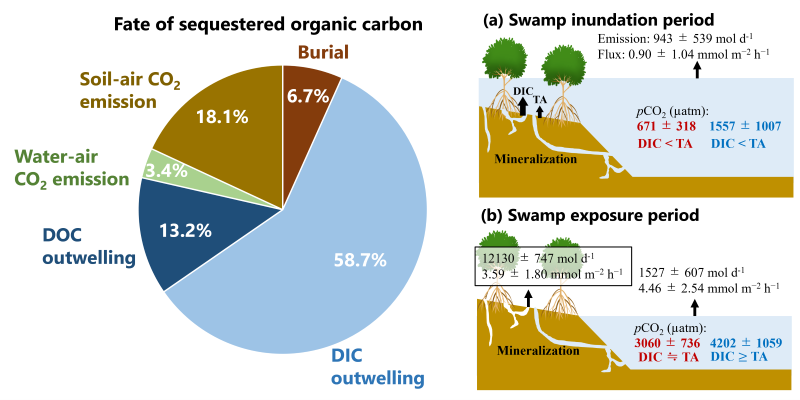
Changes in DIC/TA ratio by tidal asymmetry control pCO2 over a spring-neap tidal cycle in a subtropical mangrove forest in Japan
ABSTRACT

Mangrove creeks have large carbonate chemistry parameters (partial pressure of carbon dioxide (pCO2), dissolved inorganic carbon (DIC), and total alkalinity (TA)) owing to the porewater export by tidal pumping. In this study, the relationship between tidal oscillations and carbonate chemistry parameters was clarified, and CO2 emissions from mangrove creeks and swamps were evaluated in a mangrove forest in Japan, where the duration of swamp inundation was longer during neap tides owing tidal asymmetry. The pCO2 values in the mangrove creek ranged between 307 and 6036 μatm, with maximum values recorded at 4583 μatm during the spring tide (symmetric tide) and 6036 μatm during the neap tide (asymmetric tide). Spatiotemporal water sampling over a spring-neap tidal cycle revealed that the increase in the mangrove-derived DIC and TA varied between the inundated and exposed periods of the swamps, with DIC being produced more than TA during the inundated period. This suggests that the increase in the DIC/TA ratio as the duration of the swamp inundation increases controls the CO2 variations over a spring-neap tidal cycle in this region. Although high pCO2 values were recorded in the mangrove creeks, water-air CO2 emissions (integrating flux by inundated area) were limited to approximately 3.3% of the fate of the sequestered carbon, suggesting that approximately 94.6% of the DIC outwelled to the ocean was stored therein.
KEYWORDS
Keywords: mangrove, blue carbon, spring-neap tidal cycle, pCO2, CO2 flux, Ishigaki Island, Okinawa- Published : 2024
- Released on J-STAGE : 2024/02/27
- Received : 2023/10/23
- Accepted : 2024/01/15
- DOI : https://doi.org/10.2343/geochemj.GJ24003
- J-STAGE URL : https://www.jstage.jst.go.jp/article/geochemj/58/1/58_GJ24003/_article
- J-Online ISSN: 1880-5973
- Print ISSN : 0016-7002
- ISSN-L : 0016-7002
All Issues
- Vol.59, 2025
- Vol.58, 2024
- Vol.57, 2023
- Vol.56, 2022
- Vol.55, 2021
- Vol.54, 2020
- Vol.53, 2019
- Vol.52, 2018
- Vol.51, 2017
- Vol.50, 2016
- Vol.49, 2015
- Vol.48, 2014
- Vol.47, 2013
- Vol.46, 2012
- Vol.45, 2011
- Vol.44, 2010
- Vol.43, 2009
- Vol.42, 2008
- Vol.41, 2007
- Vol.40, 2006
- Vol.39, 2005
- Vol.38, 2004
- Vol.37, 2003
- Vol.36, 2002
- Vol.35, 2001
- Vol.34, 2000
- Vol.33, 1999
- Vol.32, 1998
- Vol.31, 1997
- Vol.30, 1996
- Vol.29, 1995
- Vol.28, 1994
- Vol.27, 1993
- Vol.26, 1992
- Vol.25, 1991
- Vol.24, 1990
- Vol.23, 1989
- Vol.22, 1988
- Vol.21, 1987
- Vol.20, 1986
- Vol.19, 1985-1986
- Vol.18, 1984
- Vol.17, 1983
- Vol.16, 1982
- Vol.15, 1981
- Vol.14, 1980
- Vol.13, 1979
- Vol.12, 1978
- Vol.11, 1977
- Vol.10, 1976
- Vol.9, 1975
- Vol.8, 1974
- Vol.7, 1973
- Vol.6, 1972-1973
- Vol.5, 1971
- Vol.4, 1970-1971
- Vol.3, 1969-1970
- Vol.2, 1968
- Vol.1, 1966-1967




